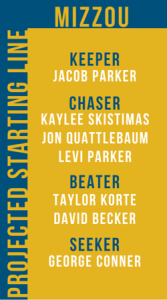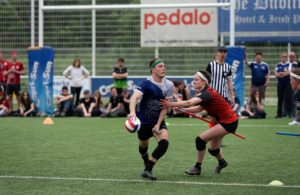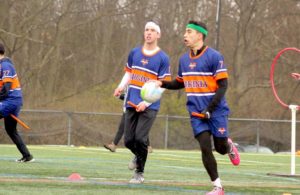- Rule, Britannia, no more?
- Unpopular Opinions: US Quadball Cup 2023
- Proven Contenders: University of Virginia
- Proven Contenders: Rutgers University
- Proven Contenders: University of Michigan
- Proven Contenders: Creighton University
- Different Perspectives: A Look Inside USA Ultimate
- Antwerp QC, Much of Belgian Core, Leaves Competitive Quidditch

Original photos by Matt Dwyer, Mecoly Dong

 University of Kansas is both one of the most historic programs in the Midwest and one of the most underachieving. Since capturing its only Midwest Regional Championship in 2011, the team has seen just one finals appearance: a loss to Bowling Green State University in 2013. Despite having some of the most athletic players in the region, Kansas seems unable to pull together at times when it matters, which is mostly as a result of an underdeveloped beating system. The team has yet to fill the massive gap left behind by former Kansas beater Samy Mousa.
University of Kansas is both one of the most historic programs in the Midwest and one of the most underachieving. Since capturing its only Midwest Regional Championship in 2011, the team has seen just one finals appearance: a loss to Bowling Green State University in 2013. Despite having some of the most athletic players in the region, Kansas seems unable to pull together at times when it matters, which is mostly as a result of an underdeveloped beating system. The team has yet to fill the massive gap left behind by former Kansas beater Samy Mousa.  Mousa was arguably the most strategic mind on the squad, and while he often ran a high-card risk, his physicality was a saving grace for the Midwest team.
Mousa was arguably the most strategic mind on the squad, and while he often ran a high-card risk, his physicality was a saving grace for the Midwest team.
This year, Kansas has attempted to fill Mousa’s shoes with veteran Shane Bouchard. Bouchard is the anchor of Kansas’ beaters, as his size allows him to shake off tackles with ease and he is able to bail out the Jayhawks’ defense with accurate, long-range beats. But there is a significant drop off in the Kansas defense when his subs step in.
Kansas also suffers from an underdeveloped group of non-male beaters, who seem to be mostly carried by their partners on the pitch.
While the Jayhawks’ high-scoring offense is usually able to outclass teams in the Midwest, more strategic teams will be able to exploit their weakness at beater. This was demonstrated at the recent Midwest Regional Championship in the squad’s Final Four game against Illinois State University. In order to truly compete with the high-level competition that will be in attendance at US Quidditch Cup 9, Kansas needs to revitalize its beater game.
 With a major overhaul necessary at beater, Kansas would benefit from running a two-male beater set more frequently, especially during snitch-on-pitch. Austin Pitts is a talented utility player and a vocal leader on-pitch whose contributions to the beater game could be the spark this team needs. Its beaters have an enormous amount of potential, but need someone with an understanding of the game to direct their positioning; Pitts has represented just that so
With a major overhaul necessary at beater, Kansas would benefit from running a two-male beater set more frequently, especially during snitch-on-pitch. Austin Pitts is a talented utility player and a vocal leader on-pitch whose contributions to the beater game could be the spark this team needs. Its beaters have an enormous amount of potential, but need someone with an understanding of the game to direct their positioning; Pitts has represented just that so  far this season at chaser, but should focus more on leading the beaters this Spring. Unless Kansas is able to bring back any former players, as they have been known to do, they will need to shift Pitts off the quaffle game in order to find success. With the Nov. 1 deadline long since passed, the Jayhawks’ are unable to potentially revitalize their roster with any players from the Crimson Warhawks. However, Mousa has moved back from Canada and is currently living near Lawrence. His status for the spring is unknown, but if he were to return to the Jayhawks, Pitts would be able to remain focused on chasing and Mousa would give the beating game a much needed overhaul.
far this season at chaser, but should focus more on leading the beaters this Spring. Unless Kansas is able to bring back any former players, as they have been known to do, they will need to shift Pitts off the quaffle game in order to find success. With the Nov. 1 deadline long since passed, the Jayhawks’ are unable to potentially revitalize their roster with any players from the Crimson Warhawks. However, Mousa has moved back from Canada and is currently living near Lawrence. His status for the spring is unknown, but if he were to return to the Jayhawks, Pitts would be able to remain focused on chasing and Mousa would give the beating game a much needed overhaul.


Riding the energy from a bracket play appearance at World Cup 8, University of Missouri started the year with high expectations. Those expectations continued to climb after a strong showing at the start of the season, with wins over the likes of Tribe Quidditch and University of Arkansas resulting in an undefeated streak at Kansas Cup.
The team, arguably, looks more complete than ever before. However, following losses to both University of Minnesota and Marquette University two weeks before the Midwest Regional Championship, along with its performance at said championship, the expectations for Mizzou have diminished.
 Let’s first look at the pre-regional losses. Becker’s importance cannot be overstated, as emphasized in Telling Number. Without him, this team falls to shambles. There are talented quaffle players among the Tigers, but they have issues scoring when Becker is not on the field to create lanes for them to attack. On defense, Becker is the focal point, and his teammates rely on him to make most defensive stops. All that being said, neutralizing Becker cripples Mizzou on both sides of the ball. The Tigers’ offense stagnates and their defense becomes porous to easy drives and alley-oops. Teams that can effectively take Becker out of the occasion have been able to take over games against Mizzou. That, however, may be easier said than done.
Let’s first look at the pre-regional losses. Becker’s importance cannot be overstated, as emphasized in Telling Number. Without him, this team falls to shambles. There are talented quaffle players among the Tigers, but they have issues scoring when Becker is not on the field to create lanes for them to attack. On defense, Becker is the focal point, and his teammates rely on him to make most defensive stops. All that being said, neutralizing Becker cripples Mizzou on both sides of the ball. The Tigers’ offense stagnates and their defense becomes porous to easy drives and alley-oops. Teams that can effectively take Becker out of the occasion have been able to take over games against Mizzou. That, however, may be easier said than done.
Becker’s quickness, arm strength and catching ability are incredible, which gives him a huge advantage in most one-and-one situations. The times he does lose those beater battles, he has strong beating partners to back him up. Taylor Korte and Maddie McConnell are phenomenal with or without a bludger and are key in allowing Becker to utilize his aggressive play style. If teams dedicate too much attention to Becker, Jacob Parker and Jacob Boyce are talented quaffle players who are strong drivers. While slowing Becker down is key to attacking Mizzou, putting too much emphasis on this one player leaves teams vulnerable in the other facets of the game.
Correction: Taylor Korte is no longer enrolled in University of Missouri. Maddie McConnell will assume her position as a starter.
 While Becker is deserving of the recognition of the attention he has received in this article, Mizzou is full of talented quaffle players. However, they have never had a real identity outside of following the holes their
While Becker is deserving of the recognition of the attention he has received in this article, Mizzou is full of talented quaffle players. However, they have never had a real identity outside of following the holes their  beaters create. While that has been proven to work for teams such as Quidditch Club Boston, issues arise when Becker is off pitch. The typical attacking style that complements Becker’s play does not work when the Tigers’ backup beaters are in the game. To counter that, Mizzou should look to slow the game down and focus on passing, similar to the offense ran by Ball State University. By keeping wide spacing and spreading the quaffle around, not only will Mizzou create more opportunities for opponents to be out of position, but it will also give Becker more time to rest on the sideline without the team having to play defense without him.
beaters create. While that has been proven to work for teams such as Quidditch Club Boston, issues arise when Becker is off pitch. The typical attacking style that complements Becker’s play does not work when the Tigers’ backup beaters are in the game. To counter that, Mizzou should look to slow the game down and focus on passing, similar to the offense ran by Ball State University. By keeping wide spacing and spreading the quaffle around, not only will Mizzou create more opportunities for opponents to be out of position, but it will also give Becker more time to rest on the sideline without the team having to play defense without him.

 Ball State University is capable of playing some of the most aesthetically pleasing quidditch in the Great Lakes. Even in poor conditions in Oxford, Ohio, Ball State took home the Quaffle House Cup title utilizing an excellent mix of pinpoint passes, offensive beating and slicing one-on-one drives. Tyler Walker and Erin Moreno are one of the more underrated beater pairs in the region, notably headlining their upset victory over Lake Effect Maelstrom in Great Lakes Regional Championship pool play by holding Ashley Calhoun and company in check. When everyone stays on their feet, the Cardinals can play with just about any team in the country.
Ball State University is capable of playing some of the most aesthetically pleasing quidditch in the Great Lakes. Even in poor conditions in Oxford, Ohio, Ball State took home the Quaffle House Cup title utilizing an excellent mix of pinpoint passes, offensive beating and slicing one-on-one drives. Tyler Walker and Erin Moreno are one of the more underrated beater pairs in the region, notably headlining their upset victory over Lake Effect Maelstrom in Great Lakes Regional Championship pool play by holding Ashley Calhoun and company in check. When everyone stays on their feet, the Cardinals can play with just about any team in the country.
Ball State has found trouble consistently when matches turn into trench wars. Maelstrom turned around in the bracket of the Great Lakes Regional Championship by daring Ball State’s quaffle core
 to find someone who could tackle David Preuter, Chris Barnard, John Gaffigan or David Wilber. No one was able to consistently step up. Bowling Green State University’s victory over Ball State in September was marked by Bowling Green’s imposing point defense and Mike Gallagher’s drives inside the keeper zone. The University of Michigan most notably blew out Ball State in Muncie because it knew the team could not be brought to the ground. The problem is not that the chasing core cannot tackle—its form is solid enough, if not textbook, and there is certainly not a lack of willing players. Ball State is just not a very big team, and top level physical quaffle players are exploiting a lack of strength. A few months of focused weight training while fixing the small flaws in form could help keep Ball State in range of more teams where they have proven deadly (4-1 in SWIM situations this season).
to find someone who could tackle David Preuter, Chris Barnard, John Gaffigan or David Wilber. No one was able to consistently step up. Bowling Green State University’s victory over Ball State in September was marked by Bowling Green’s imposing point defense and Mike Gallagher’s drives inside the keeper zone. The University of Michigan most notably blew out Ball State in Muncie because it knew the team could not be brought to the ground. The problem is not that the chasing core cannot tackle—its form is solid enough, if not textbook, and there is certainly not a lack of willing players. Ball State is just not a very big team, and top level physical quaffle players are exploiting a lack of strength. A few months of focused weight training while fixing the small flaws in form could help keep Ball State in range of more teams where they have proven deadly (4-1 in SWIM situations this season).
 If you have big athletes on your bench that play behind speedier options, this is where you play them. Ball State is as fast as they come and the Cardinals want you to play into their open style that highlights aggressive beating and smooth passing. Take the pace out of the game, let your beaters have plenty of time to clear out a driving lane and have your physical players drive into the keeper zone. If you know you have the physical advantage, do not
If you have big athletes on your bench that play behind speedier options, this is where you play them. Ball State is as fast as they come and the Cardinals want you to play into their open style that highlights aggressive beating and smooth passing. Take the pace out of the game, let your beaters have plenty of time to clear out a driving lane and have your physical players drive into the keeper zone. If you know you have the physical advantage, do not  play outside that element just because a few drives fail. Keep trying to use that size and be patient, and you will wear them down over time.
play outside that element just because a few drives fail. Keep trying to use that size and be patient, and you will wear them down over time.
Blake Fitzgerald is going to run the show on offense. He is much faster than he appears and he has excellent mid-range shooting and passing when he reaches the edge of your zone. Try to have your point defenders meet him early to not let him gain momentum. If you do not have bigger players, you have to win the beating game—a tall task when Moreno and Walker share the field. Giving that pair a lion’s share of bludger control makes staying in range horribly difficult, let alone winning. Jason Bowling is still one of the best seekers in the country and leaving a match in range usually ends with him grabbing the snitch. Get out of range at all costs.

 Ohio University is hands down the most improved team in the Great Lakes from the 2014-15 season. Half of that improvement is due to how most teams improve—the new recruits are notably more athletic and dedicated than what Ohio would bring in past seasons. The other half? A dedication to a specific strategy that brings out the best in the program’s athletes. Ohio does not have a lot of beaters with powerful, accurate arms, and its chasers’ passing game still needs a lot of refinement.
Ohio University is hands down the most improved team in the Great Lakes from the 2014-15 season. Half of that improvement is due to how most teams improve—the new recruits are notably more athletic and dedicated than what Ohio would bring in past seasons. The other half? A dedication to a specific strategy that brings out the best in the program’s athletes. Ohio does not have a lot of beaters with powerful, accurate arms, and its chasers’ passing game still needs a lot of refinement.  The solution: consistently use the 1.5 beating strategy on offense and follow beaters in for close range shots or easy dump-off goals. Unfortunately for Ohio, once it runs into a team that has either more physical beaters or enough chasers that can consistently tackle, the Bobcats struggle to score. When they run into teams that have both—such as the University of Michigan and Bowling Green State University at the Great Lakes Regional Championship—Ohio quickly gets blown out. The first step of deciding how to play as a team has been a major success; Ohio University just needs to take the next step of learning to adjust and play a different game if it wants to challenge Top-20 teams.
The solution: consistently use the 1.5 beating strategy on offense and follow beaters in for close range shots or easy dump-off goals. Unfortunately for Ohio, once it runs into a team that has either more physical beaters or enough chasers that can consistently tackle, the Bobcats struggle to score. When they run into teams that have both—such as the University of Michigan and Bowling Green State University at the Great Lakes Regional Championship—Ohio quickly gets blown out. The first step of deciding how to play as a team has been a major success; Ohio University just needs to take the next step of learning to adjust and play a different game if it wants to challenge Top-20 teams.
 Taking down this Ohio University team reminds me a lot of playing the old Michigan teams back in the days of World Cup VI quidditch. The Bobcats’ beaters are going to run you over every chance they get. On offense, you are not going to score very often while standing on your feet, so be ready to get hit. While on defense, Michigan used to
Taking down this Ohio University team reminds me a lot of playing the old Michigan teams back in the days of World Cup VI quidditch. The Bobcats’ beaters are going to run you over every chance they get. On offense, you are not going to score very often while standing on your feet, so be ready to get hit. While on defense, Michigan used to  run through Andrew Axtell, who could block most bludgers thrown in his way while running through, around and over any would-be tacklers. Axtell’s role is taken by new recruit Joe Dent, one of the best new players the Great Lakes has seen since Chris Barnard. Dent plays in a similar style to those two greats: once the ball is in his hand, it is likely not leaving until he either scores or turns it over. In two months of competitive play, Dent has learned how to keep his eyes up for some good options in Noah Boettner and Ryan Scott, but his passing is not quite there yet to be worried about anything more than simple quick-hit assists near the hoops. If your team struggles with defending the 1.5 or tackling big, charging quaffle players, you are going to be in serious trouble. Scott is a dependable option at seeker, but usually needs time to figure out good snitches. Do not give him multiple open runs or you could find yourself on the wrong side of the scoreboard.
run through Andrew Axtell, who could block most bludgers thrown in his way while running through, around and over any would-be tacklers. Axtell’s role is taken by new recruit Joe Dent, one of the best new players the Great Lakes has seen since Chris Barnard. Dent plays in a similar style to those two greats: once the ball is in his hand, it is likely not leaving until he either scores or turns it over. In two months of competitive play, Dent has learned how to keep his eyes up for some good options in Noah Boettner and Ryan Scott, but his passing is not quite there yet to be worried about anything more than simple quick-hit assists near the hoops. If your team struggles with defending the 1.5 or tackling big, charging quaffle players, you are going to be in serious trouble. Scott is a dependable option at seeker, but usually needs time to figure out good snitches. Do not give him multiple open runs or you could find yourself on the wrong side of the scoreboard.

 A poor World Cup 8 showing notwithstanding, Ohio State had its best full season in 2014-2015, winning 30 matches and capturing its first regional championship at Midwest Regional Cup Championship. Crisp passing and deep lines were the hallmark of that successful team, both of which have all but
A poor World Cup 8 showing notwithstanding, Ohio State had its best full season in 2014-2015, winning 30 matches and capturing its first regional championship at Midwest Regional Cup Championship. Crisp passing and deep lines were the hallmark of that successful team, both of which have all but  disappeared this season. Of the 21 players on that World Cup 8 roster, only nine returned this season, resulting in the Buckeyes struggling heavily early in the year as they tried to integrate new talent. The team’s beating game especially took a rough hit, with only Julie Fritz and Jordan Reding returning from the varsity team.
disappeared this season. Of the 21 players on that World Cup 8 roster, only nine returned this season, resulting in the Buckeyes struggling heavily early in the year as they tried to integrate new talent. The team’s beating game especially took a rough hit, with only Julie Fritz and Jordan Reding returning from the varsity team.
The Great Lakes Regional Championship showed the potential beginnings of an upturn for the Buckeyes, but things have to keep on moving from there if they want to keep moving forward as a team. One of the biggest reasons Ohio State struggled at World Cup 8 was a lack of playing time and rust having built up. For what is now one of the more inexperienced squads attending US Quidditch Cup 9, Ohio State needs to play as much as possible these upcoming months to prevent the rust from building up, as well as to gain more experience for their new players.
 If you’re basing any of your game plan on last year’s Buckeyes, throw it out and start from scratch. Ohio State has taken a clear step down but is no pushover, as Lake Effect Tempest and Miami University learned the hard way when the Buckeyes made a surprise semifinal showing. Brien “Baby Beluga” Polivka is your main focus when Jeremy Boettner is beating. He has a streaky long shot and can drive through defenses with ease, so try to keep him away from the hoops and force him to make the long passes he struggles with. The returners and new players in the quaffle core all have speed on their side, but size and tackling ability are hard to come by behind Polivka. When Boettner is chasing, he’s looking for teammate Chris Bowman first. The two of them run one of the more effective give-and-go offenses in the region and thrive off momentum, so shut them down early before they can get going.
If you’re basing any of your game plan on last year’s Buckeyes, throw it out and start from scratch. Ohio State has taken a clear step down but is no pushover, as Lake Effect Tempest and Miami University learned the hard way when the Buckeyes made a surprise semifinal showing. Brien “Baby Beluga” Polivka is your main focus when Jeremy Boettner is beating. He has a streaky long shot and can drive through defenses with ease, so try to keep him away from the hoops and force him to make the long passes he struggles with. The returners and new players in the quaffle core all have speed on their side, but size and tackling ability are hard to come by behind Polivka. When Boettner is chasing, he’s looking for teammate Chris Bowman first. The two of them run one of the more effective give-and-go offenses in the region and thrive off momentum, so shut them down early before they can get going.
 Boettner as a beater is about what you would expect: he’s a great athlete who is still learning the nuances of the game. If you don’t pressure him and let him do what he wants, he’s going to force some good plays. Keep him on his toes with unconventional looks and he’s likely to overstretch himself and leave his partner out to dry. The Ohio State defense likes to use a point beater rather than chaser- aggressive beating is much higher risk-reward than against a normal defense. If you have the advantage in the beater game, bring them up on offense and play the long-term percentages.
Boettner as a beater is about what you would expect: he’s a great athlete who is still learning the nuances of the game. If you don’t pressure him and let him do what he wants, he’s going to force some good plays. Keep him on his toes with unconventional looks and he’s likely to overstretch himself and leave his partner out to dry. The Ohio State defense likes to use a point beater rather than chaser- aggressive beating is much higher risk-reward than against a normal defense. If you have the advantage in the beater game, bring them up on offense and play the long-term percentages.
As a team, the Buckeyes haven’t played together long enough to have a signature style. Most of their players have more speed than size, so a linear offense can be very effective. There aren’t a lot of strategic breakdowns on either side of the ball, so whatever your strengths as a team are, exploit them. Something to keep an eye on this semester: captain Fritz graduated over the winter and her status on the team is uncertain. If she does not play, the Buckeyes beating game becomes a weakness. Their new recruits and those called up from the program’s B-team aren’t bad athletes but Fritz has been leaned upon for so long that learning how to play without her will prove a tall challenge.



